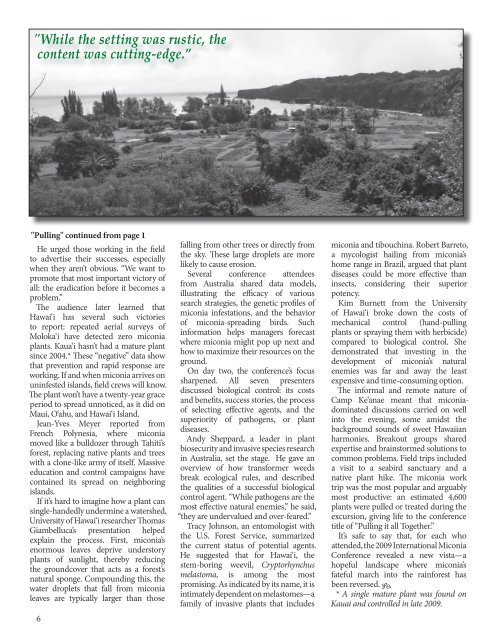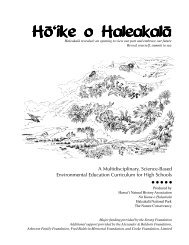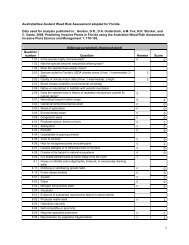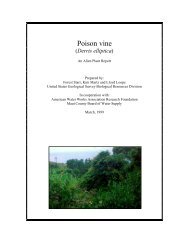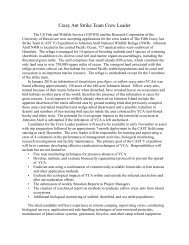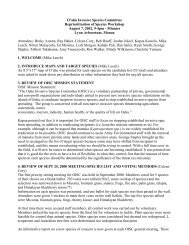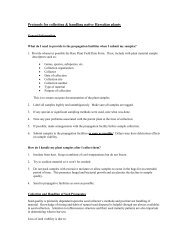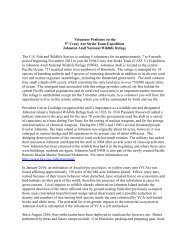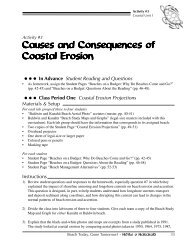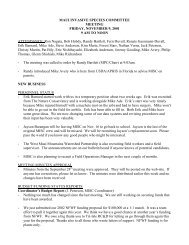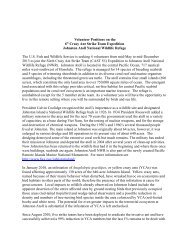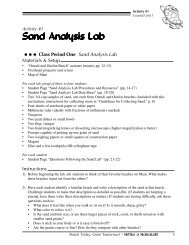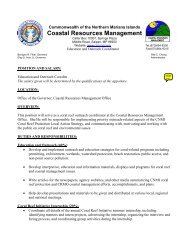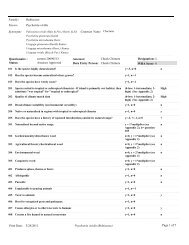Kiai i Na Moku o Maui Nui - Hawaiian Ecosystems at Risk project
Kiai i Na Moku o Maui Nui - Hawaiian Ecosystems at Risk project
Kiai i Na Moku o Maui Nui - Hawaiian Ecosystems at Risk project
Create successful ePaper yourself
Turn your PDF publications into a flip-book with our unique Google optimized e-Paper software.
"While the setting was rustic, the<br />
content was cutting-edge.”<br />
"Pulling" continued from page 1<br />
He urged those working in the field<br />
to advertise their successes, especially<br />
when they aren’t obvious. “We want to<br />
promote th<strong>at</strong> most important victory of<br />
all: the eradic<strong>at</strong>ion before it becomes a<br />
problem.”<br />
The audience l<strong>at</strong>er learned th<strong>at</strong><br />
Hawai‘i has several such victories<br />
to report: repe<strong>at</strong>ed aerial surveys of<br />
Moloka‘i have detected zero miconia<br />
plants. Kaua‘i hasn’t had a m<strong>at</strong>ure plant<br />
since 2004.* These “neg<strong>at</strong>ive” d<strong>at</strong>a show<br />
th<strong>at</strong> prevention and rapid response are<br />
working. If and when miconia arrives on<br />
uninfested islands, field crews will know.<br />
The plant won’t have a twenty-year grace<br />
period to spread unnoticed, as it did on<br />
<strong>Maui</strong>, O‘ahu, and Hawai‘i Island.<br />
Jean-Yves Meyer reported from<br />
French Polynesia, where miconia<br />
moved like a bulldozer through Tahiti’s<br />
forest, replacing n<strong>at</strong>ive plants and trees<br />
with a clone-like army of itself. Massive<br />
educ<strong>at</strong>ion and control campaigns have<br />
contained its spread on neighboring<br />
islands.<br />
If it’s hard to imagine how a plant can<br />
single-handedly undermine a w<strong>at</strong>ershed,<br />
University of Hawai‘i researcher Thomas<br />
Giambelluca’s present<strong>at</strong>ion helped<br />
explain the process. First, miconia’s<br />
enormous leaves deprive understory<br />
plants of sunlight, thereby reducing<br />
the groundcover th<strong>at</strong> acts as a forest’s<br />
n<strong>at</strong>ural sponge. Compounding this, the<br />
w<strong>at</strong>er droplets th<strong>at</strong> fall from miconia<br />
leaves are typically larger than those<br />
6<br />
falling from other trees or directly from<br />
the sky. These large droplets are more<br />
likely to cause erosion.<br />
Several conference <strong>at</strong>tendees<br />
from Australia shared d<strong>at</strong>a models,<br />
illustr<strong>at</strong>ing the efficacy of various<br />
search str<strong>at</strong>egies, the genetic profiles of<br />
miconia infest<strong>at</strong>ions, and the behavior<br />
of miconia-spreading birds. Such<br />
inform<strong>at</strong>ion helps managers forecast<br />
where miconia might pop up next and<br />
how to maximize their resources on the<br />
ground.<br />
On day two, the conference’s focus<br />
sharpened. All seven presenters<br />
discussed biological control: its costs<br />
and benefits, success stories, the process<br />
of selecting effective agents, and the<br />
superiority of p<strong>at</strong>hogens, or plant<br />
diseases.<br />
Andy Sheppard, a leader in plant<br />
biosecurity and invasive species research<br />
in Australia, set the stage. He gave an<br />
overview of how transformer weeds<br />
break ecological rules, and described<br />
the qualities of a successful biological<br />
control agent. “While p<strong>at</strong>hogens are the<br />
most effective n<strong>at</strong>ural enemies,” he said,<br />
“they are undervalued and over-feared.”<br />
Tracy Johnson, an entomologist with<br />
the U.S. Forest Service, summarized<br />
the current st<strong>at</strong>us of potential agents.<br />
He suggested th<strong>at</strong> for Hawai‘i, the<br />
stem-boring weevil, Cryptorhynchus<br />
melastoma, is among the most<br />
promising. As indic<strong>at</strong>ed by its name, it is<br />
intim<strong>at</strong>ely dependent on melastomes—a<br />
family of invasive plants th<strong>at</strong> includes<br />
miconia and tibouchina. Robert Barreto,<br />
a mycologist hailing from miconia’s<br />
home range in Brazil, argued th<strong>at</strong> plant<br />
diseases could be more effective than<br />
insects, considering their superior<br />
potency.<br />
Kim Burnett from the University<br />
of Hawai‘i broke down the costs of<br />
mechanical control (hand-pulling<br />
plants or spraying them with herbicide)<br />
compared to biological control. She<br />
demonstr<strong>at</strong>ed th<strong>at</strong> investing in the<br />
development of miconia’s n<strong>at</strong>ural<br />
enemies was far and away the least<br />
expensive and time-consuming option.<br />
The informal and remote n<strong>at</strong>ure of<br />
Camp Ke‘anae meant th<strong>at</strong> miconiadomin<strong>at</strong>ed<br />
discussions carried on well<br />
into the evening, some amidst the<br />
background sounds of sweet <strong>Hawaiian</strong><br />
harmonies. Breakout groups shared<br />
expertise and brainstormed solutions to<br />
common problems. Field trips included<br />
a visit to a seabird sanctuary and a<br />
n<strong>at</strong>ive plant hike. The miconia work<br />
trip was the most popular and arguably<br />
most productive: an estim<strong>at</strong>ed 4,600<br />
plants were pulled or tre<strong>at</strong>ed during the<br />
excursion, giving life to the conference<br />
title of “Pulling it all Together.”<br />
It’s safe to say th<strong>at</strong>, for each who<br />
<strong>at</strong>tended, the 2009 Intern<strong>at</strong>ional Miconia<br />
Conference revealed a new vista—a<br />
hopeful landscape where miconia’s<br />
f<strong>at</strong>eful march into the rainforest has<br />
been reversed. •<br />
* A single m<strong>at</strong>ure plant was found on<br />
Kauai and controlled in l<strong>at</strong>e 2009.


